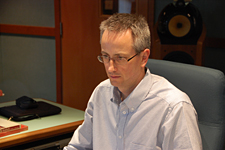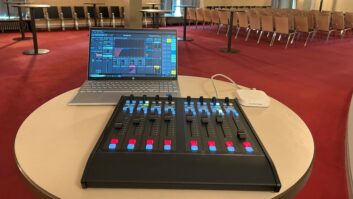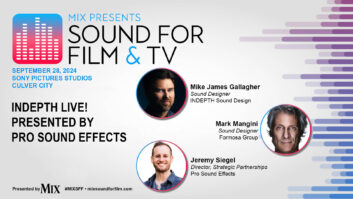
Abbey Road audio restoration engineer Simon Gibson
Prism Sound converters and SADiE mastering equipment played a vital role in Abbey Road’s four-year project to digitally re-master the entire original Beatles catalog. The project involved 13 albums and took many hours of work by Abbey Road’s specialist engineering team.
The project was led by project coordinator Allan Rouse and included senior recording engineer Guy Massey, senior mastering engineer Steve Rooke, recording engineer Paul Hicks, mastering engineer Sean Magee, recording engineer Sam Okell and audio restoration engineer Simon Gibson (pictured).
Massey and Hicks undertook the first part of the process, which involved transferring each song from analog tape into the digital domain. They used Prism Sound’s ADA-8XR multichannel modular AD/DA converters to transfer the material into Pro Tools and then format the songs as 24-bit/192 kHz, as well as video reference them.
At this stage Gibson took over. Using a SADiE 5 system with built-in Cedar Retouch, Gibson began the careful process of restoring the audio without compromising the character of the original recordings. He used de-noising technology subtly and sparingly to remove noises such as audible clicks and pops from mics and faders, but performance-based imperfections, such as breaths and coughs, were retained.
“The integration of Cedar Retouch into SADiE 5 has literally changed the way I work by making the whole restoration process much quicker, easier and more precise,” Gibson says. “The visual element provided by SADiE was essential on this project because I was able to zoom in and actually see what was happening to the audio. By changing the zoom I could look at the mid- and low range frequencies and see how to get the best out of them. Each song on each album had its own issues, but with SADiE 5 and Cedar Retouch I could easily identify problems such as tape drop outs because the broad upper frequency shading was interrupted by a thin strip, which indicated where the audio needed gating.”
While Gibson was restoring the album tracks, he also used his SADiE 5 and Cedar Retouch system to help Giles Martin and Paul Hicks create the audio for The Beatles: Rock Band videogame.
“In order to use the original songs within the game we had to isolate individual instruments and voices so that players can have individual control. Given that many of the Beatles’ earlier recordings were done on 2- or 4-track tape, this was quite a tall order. However, with SADie 5 and Cedar Retouch I was able to pick them apart note by note and effectively rub out the frequencies we didn’t want. It was incredibly labor intensive and took ages to do, but the results were worth it because the majority of The Beatles catalog can now be used in the game.”
Throughout the entire restoration and re-mastering process immense care was taken to maintain the authenticity and integrity of the original analog recordings. The whole team deliberated every change at every step of the way to ensure that the audio remained as pure as possible.
“We didn’t want to have a negative effect on the resulting audio,” Gibson says. “Instead, we wanted to end up with audio that was as close as possible to the original, recorded studio sound. In terms of audio restoration this meant taking a subtle, almost forensic approach to the job. I was fortunate to have both the time and budget to do this.”
Following restoration, all 13 albums were mastered by Steve Rooke and Sean Magee, who handled the stereo and mono recordings respectively. Once again a SADiE Series 5 PCM 8 DAW played a part in the mastering process, as did Prism Sound converters, which were used to transfer the audio back into the analog domain and for noise shaping. Most of the EQ’ing was done on Abbey Road’s 1972 EMI TG mastering console, but a Prism Sound MEA2 was also used for additional EQ where finer steps or specific target frequencies were required.
Abbey Road’s marathon project finally came to fruition on September 9 when all 13 of the re-mastered albums were released through EMI Music and Apple Corps.
For more information, visit Prism Sound’s Recording and Production home page and www.sadie.com.







